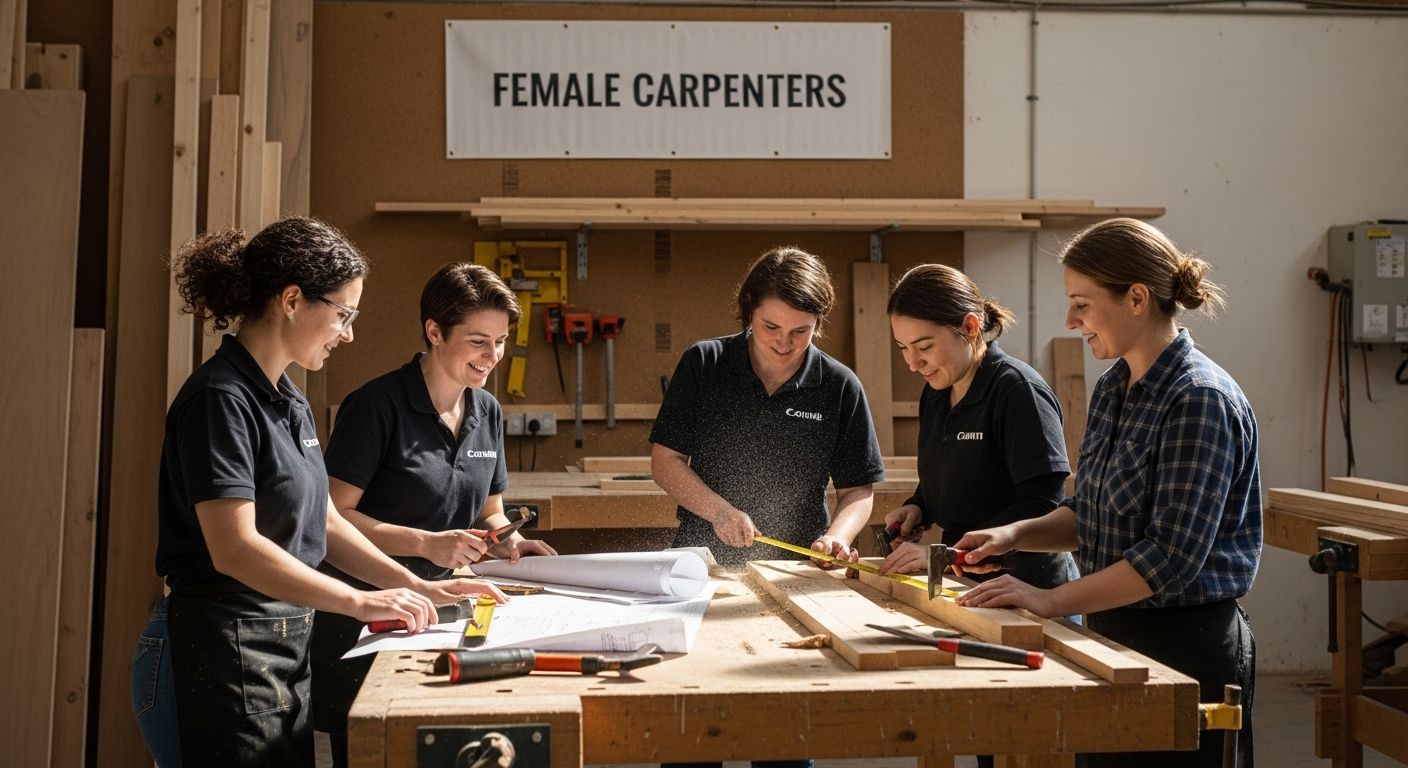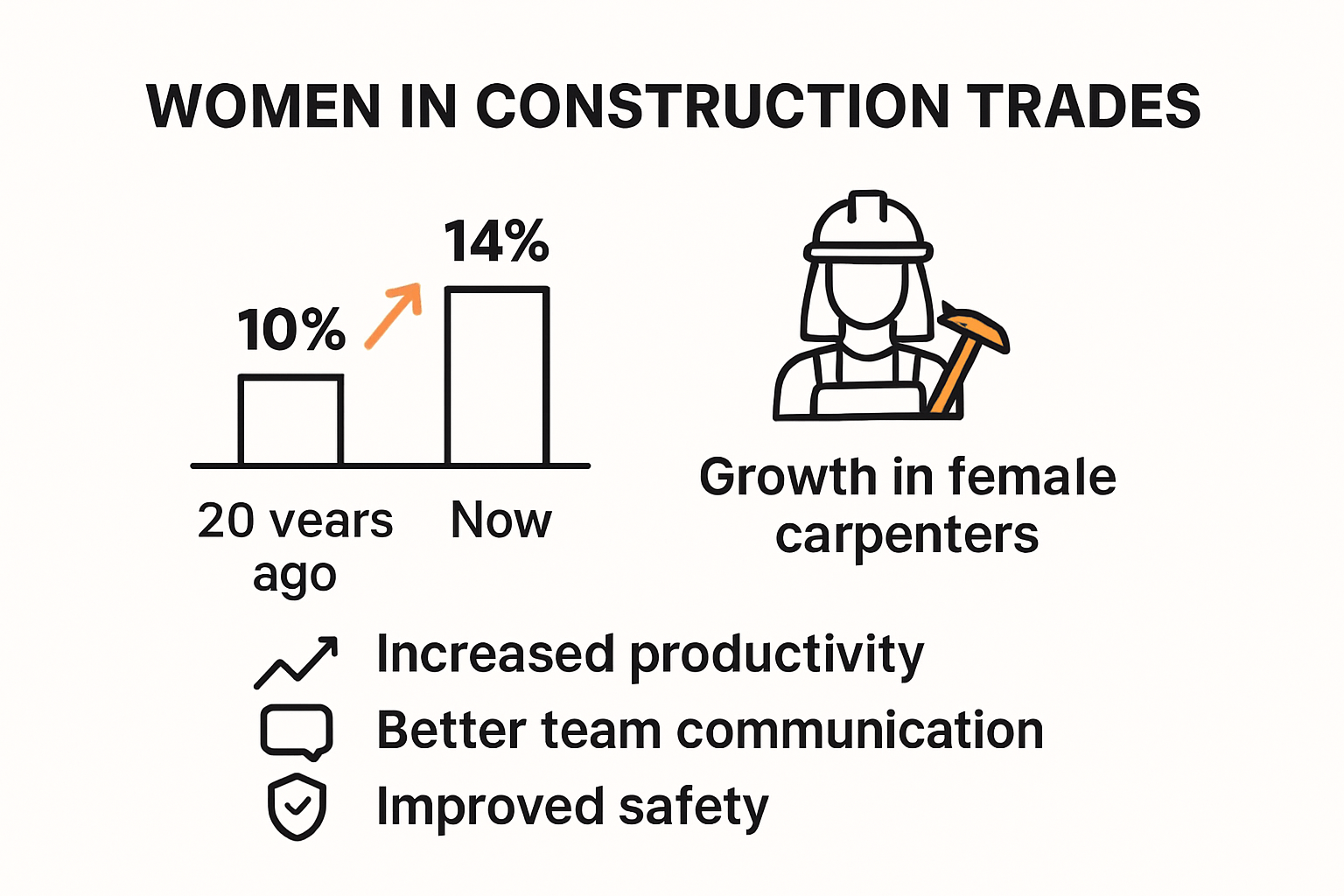Female carpenters are showing up in shops and build sites everywhere, changing what people expect from the construction industry. Most are surprised when they hear that women now make up about 10.3 percent of all construction trade workers, and that number keeps rising. The real shift is not just in numbers but in how these skilled women are rewriting the rules, bringing new ideas, advanced technical know-how, and a fresh approach to a field that once tried to keep them out.

Table of Contents
- What Defines A Female Carpenter In Today’s Workforce?
- Why Female Carpenters Matter In The Construction Industry?
- How The Role Of Female Carpenters Is Evolving And Influencing Change?
- Key Concepts In Carpentry: Tools, Techniques, And Skills For Success
Quick Summary
| Takeaway | Explanation |
|---|---|
| Female carpenters possess advanced technical skills | They master blueprint reading, structural design, and innovative woodworking techniques, proving their expertise in the field. |
| They enhance team performance and safety | Their diverse skill set improves communication, reduces accidents, and increases efficiency in construction environments. |
| Women are breaking gender barriers in construction | The growing presence of female carpenters challenges stereotypes and opens pathways for future generations in skilled trades. |
| Educational pathways are evolving for inclusivity | New training programs and mentorship initiatives are designed to support women’s entry into carpentry and related fields. |
| Technological integration is key to modern carpentry | Female carpenters leverage advanced digital tools and fabrication methods, transforming traditional practices into innovative solutions. |
What Defines a Female Carpenter in Today’s Workforce?
Female carpenters are skilled professionals challenging traditional construction industry norms by bringing precision, technical expertise, and innovative perspectives to woodworking and building trades. These women are not just participants but transformative contributors reshaping how carpentry work is perceived and executed.
Technical Competence and Skill Mastery
Modern female carpenters demonstrate exceptional technical competence across multiple domains. Their skill set encompasses blueprint reading, advanced mathematics, structural design understanding, tool operation, and sophisticated woodworking techniques. Unlike outdated stereotypes, these professionals bring rigorous training and academic preparation to job sites, often holding technical degrees or completing comprehensive apprenticeship programs.
To better understand the advanced skill set todays female carpenters bring to the workforce, heres a breakdown of essential technical competencies highlighted in the article:
| Technical Competency | Description |
|---|---|
| Architectural blueprint interpretation | Ability to accurately read and understand detailed construction and architectural plans |
| Structural engineering principles | Knowledge of foundational concepts that determine the safety and strength of buildings |
| Advanced wood joinery techniques | Proficiency with complex methods for connecting and securing pieces of wood |
| Precision measurement and cutting | Highly accurate measuring and cutting of materials for quality craftsmanship |
| Digital design and computer-aided drafting | Use of digital tools and software like CAD for precise layouts and designs |

Key Technical Competencies Include:
- Architectural blueprint interpretation
- Structural engineering principles
- Advanced wood joinery techniques
- Precision measurement and cutting skills
- Digital design and computer-aided drafting
Breaking Professional Barriers
Female carpenters are actively dismantling long-standing gender barriers within construction trades. According to Bureau of Labor Statistics, women represent approximately 10.3% of construction trade workers, with carpentry showing steady growth in female representation. These professionals challenge workplace cultures by demonstrating unparalleled technical skills, professionalism, and resilience.
Explore our guide on women transforming trade careers to understand how female carpenters are redefining industry expectations and creating inclusive work environments. Their contributions extend beyond technical skills, introducing collaborative approaches, safety consciousness, and innovative problem-solving strategies that benefit entire construction teams.
Why Female Carpenters Matter in the Construction Industry?
Female carpenters are not just filling workforce gaps but fundamentally transforming construction industry dynamics through unique skills, perspectives, and innovative problem-solving approaches that challenge traditional workplace paradigms.
Economic and Performance Impact
The integration of female carpenters delivers substantial economic and performance benefits to construction organizations. These professionals bring diverse skill sets that enhance team productivity, reduce workplace accidents, and introduce more comprehensive safety protocols. Research indicates that diverse teams demonstrate higher problem-solving capabilities and increased operational efficiency.
The following table summarizes the key performance and cultural impacts that female carpenters contribute to the construction industry:
| Contribution Type | Example Impact |
|---|---|
| Team Communication | Enhanced communication strategies and collaboration |
| Safety Protocols | More comprehensive risk assessment and reduced accidents |
| Innovation in Problem-Solving | Creative design and structural solutions |
| Workplace Culture | Improved inclusivity and team dynamics |
| Operational Efficiency | Increased productivity and streamlined workflows |

Key Performance Contributions:
- Enhanced team communication strategies
- More comprehensive risk assessment techniques
- Improved collaborative work environments
- Innovative design and structural problem-solving
- Reduced workplace safety incidents
Breaking Systemic Industry Barriers
According to National Women’s Law Center, female carpenters are actively dismantling long-standing gender barriers by proving technical competence and resilience. Their presence challenges historical workplace stereotypes, creating pathways for future generations of women in skilled trades.
Check out our comprehensive guide on empowering women in trade careers to understand how female carpenters are reshaping industry perspectives. Their contributions extend beyond individual achievements, representing a broader movement toward workplace inclusivity, diversity, and equal professional opportunities in construction and carpentry sectors.
How the Role of Female Carpenters is Evolving and Influencing Change?
The landscape of carpentry is undergoing a profound transformation, with female professionals driving innovative shifts in skill development, workplace culture, and industry perspectives. These changes represent more than workforce diversification they signal a fundamental reimagining of traditional construction trade dynamics.
Educational and Professional Pathways
Modern female carpenters are pioneering new professional development strategies that challenge historical barriers. Technical training programs, apprenticeship opportunities, and specialized certifications are increasingly designed with gender inclusivity in mind. Women are actively pursuing advanced technical education, acquiring sophisticated digital design skills, and leveraging technology to enhance traditional carpentry techniques.
Emerging Professional Development Trends:
- Advanced digital fabrication training
- Specialized technical certification programs
- Mentorship and leadership development initiatives
- Cross disciplinary skill integration
- Technology enhanced construction methodologies
Systemic Industry Transformation
According to National Association of Women in Construction, female carpenters are catalyzing systemic industry changes by challenging traditional workplace norms. Their presence introduces more collaborative leadership models, comprehensive safety protocols, and innovative problem solving approaches that benefit entire construction ecosystems.
Discover how women are reshaping trade career opportunities to understand the profound impact of female professionals in carpentry. These trailblazers are not just adapting to existing structures but actively reconstructing industry standards, creating more inclusive, dynamic, and technologically advanced work environments that promise a more equitable future for skilled trades.
Key Concepts in Carpentry: Tools, Techniques, and Skills for Success
Carpentry represents a sophisticated blend of technical knowledge, precise craftsmanship, and adaptive problem solving. Female carpenters are elevating these professional standards by bringing innovative approaches to traditional woodworking and construction methodologies.
Essential Technical Foundations
Successful carpentry demands a comprehensive understanding of tools, materials, and complex spatial reasoning skills. Modern carpenters must master both traditional hand tools and advanced digital technologies. This requires developing intricate knowledge of wood properties, structural design principles, and sophisticated measurement techniques that go beyond simple construction tasks.
Critical Technical Skills:
- Precision measurement techniques
- Advanced blueprint interpretation
- Material stress and structural analysis
- Digital design and fabrication technologies
- Complex geometric calculation methods
Professional Tool Mastery
Professional carpenters require an extensive toolkit that combines traditional craftsmanship with cutting edge technological capabilities. According to American Carpentry Association, essential tools range from classic hand tools like chisels and levels to advanced power equipment and digital measurement systems. The ability to select, maintain, and strategically utilize these tools distinguishes exceptional practitioners.
Learn about specialized trade gear for professional carpenters to understand how proper equipment enhances workplace performance. Successful female carpenters recognize that tool mastery extends beyond physical manipulation to understanding each instrument’s specific application, maintenance requirements, and potential performance limitations.
Empower Your Next Project with Workwear Designed for Female Carpenters
Today’s female carpenters face the pressures of breaking industry barriers and demanding reliable apparel that matches their confidence and skill. This article highlights how professional women in carpentry need advanced technical gear, comfort, and protection for long days on site. But finding workwear that truly fits both function and style is a real challenge.
Explore how WorkwearComfort.com creates apparel to meet these exact needs. From UPF 50+ protective hoodies to women’s trade workwear engineered for durability and tailored strength, our collection empowers you to focus on your craft and smash industry stereotypes. You deserve gear that is as resilient and innovative as you are.

Take control of your workday with clothing designed for today’s female professionals. Visit WorkwearComfort.com now to see how our women’s workwear supports both your career and your individuality. Make your next step one that champions strength, fits right, and feels good—for every job, big or small.
Frequently Asked Questions
What skills are essential for female carpenters?
Successful female carpenters should master skills such as precision measurement, advanced blueprint interpretation, material stress analysis, and proficiency in both traditional and digital tools.
How are female carpenters breaking barriers in the construction industry?
Female carpenters are challenging gender stereotypes by proving their technical competence, promoting better workplace cultures, and paving the way for future generations in skilled trades.
What kind of training do female carpenters typically undergo?
Many female carpenters participate in technical training programs, apprenticeships, and obtain specialized certifications that focus on both traditional carpentry and modern technology, promoting gender inclusivity.
What impact do female carpenters have on construction team productivity?
Research shows that diverse teams, including female carpenters, improve communication, enhance problem-solving abilities, and increase operational efficiency, resulting in a positive impact on overall productivity.


